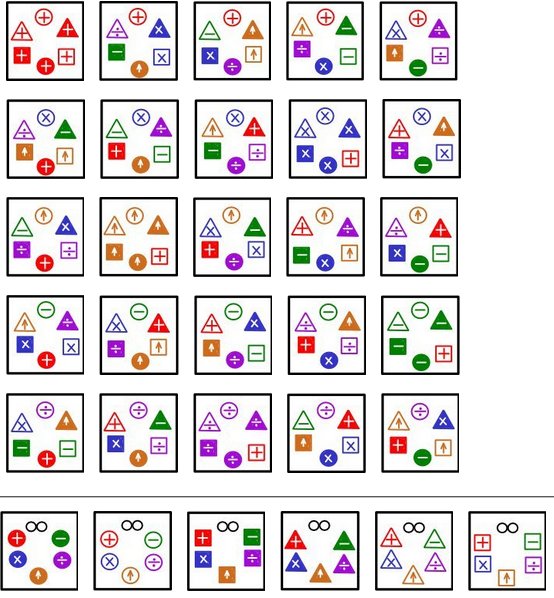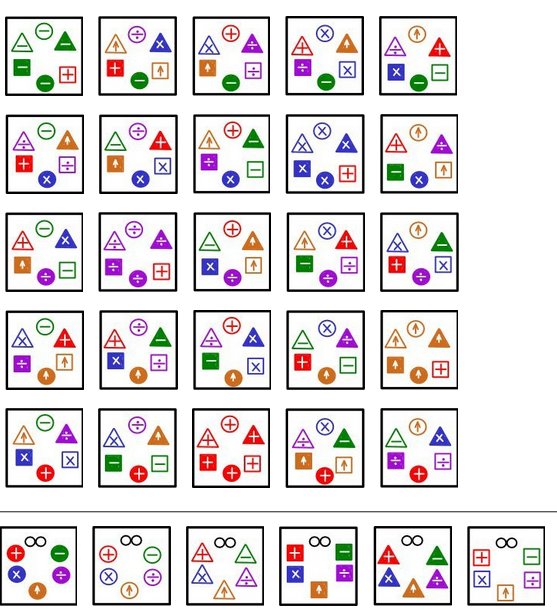The goal of this puzzle is to place 25 cards in a 5x5 grid so that each row, column, and diagonal (in both directions) contains some unique common symbol. For example, the first row has a common symbol which is identifies it as belonging to that set, and none of the remaining 20 cards within the 5x5 grid have this symbol. The board in use is actually a "torus" or "wrap-around" board, such as used in PAC-MAN, so diagonals which do not go corner-to-corner will wrap around to the other side of the board, much like a label wraps around a soup can.
In addition to these constraints, there are additonal sets of 5 which are harder to visualize but which are mathematically equivalent. They must be in certain spots relative to each other, but these conditions will be satisified as a side effect on this size puzzle.
To solve this puzzle, here are some hints.
First, pull aside any 6 cards containing some common symbol. If this is your first time playing, the infinity (sideways 8) is the easiest symbol to use for this purpose, as the remaining sets will have convenient properties.
Second, pick one of the discarded cards to use as your columns indicator. Make columns of 5 cards, each column containing one of the symbols off of this special discarded card you have chosen.
Third, pick another (different) discarded card to use as your rows indicator. Rearrange cards only within the columns so that each column still retains its common symbol, but now each row also has a common symbol.
Fourth, pick any symbol which has not yet been used as a row or column symbol (and is also not the symbol indicating the original discard set), and use that new symbol to form the main diagonal, running from the lower left corner to the upper right corner of the grid. This can be done without disturbing the row sets or the column sets, by swapping any two rows or any two columns.
Fifth, assume the card in the center is in the correct position. The remaining step is very quick but will take awhile to explain.
Look for the symbol which will become the second diagonal, running from the upper left corner to the lower right corner. Since this symbol will be on the card in the center, there are only 3 possible symbols to consider. Just one of these three will work if you try to put it on the second diagonal. If you try one of the other two, you will just end up "going around in circles". Assuming it hasn't already solved itself at this stage, you have to choose a symbol which isn't anywhere in the diagonal except for in the middle spot. This is because you have to swap two sets of cards at a time.
You will not want to disturb your row sets, column sets, or your first diagonal set. So, the moves you make now will involve swapping two rows followed by two columns (or vice versa) so long as these rows/columns have the same indices. We number rows from lowest to highest and columns from leftmost to rightmost. So, if we swap the two rightmost columns, we must also swap the two highest columns, and so forth.
The move sequences you should be weighing at this point are:
A) swap the first and last column and also the first and last row
B) swap the second and last column and also the second and last row
C) swap the first and second columns, the fourth and fifth columns, the first and second rows, and the fourth and fifth rows.
Those remaining sequences should solve the puzzle, regardless of whether you
managed to figure out which symbol needed to become the counterdiagonal.
Finally, if it's not solved after you have set the diagonal and the counterdiagonal, perform sequence A) above.
Click on the thumbnails below to see examples of the solved puzzle.


